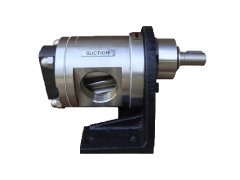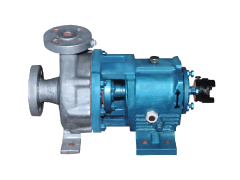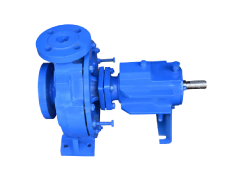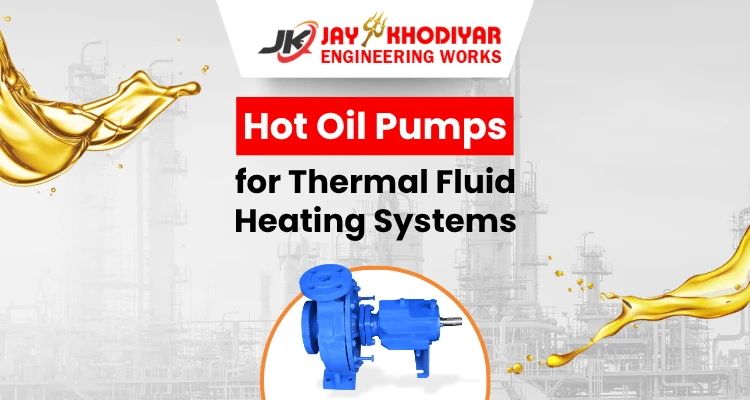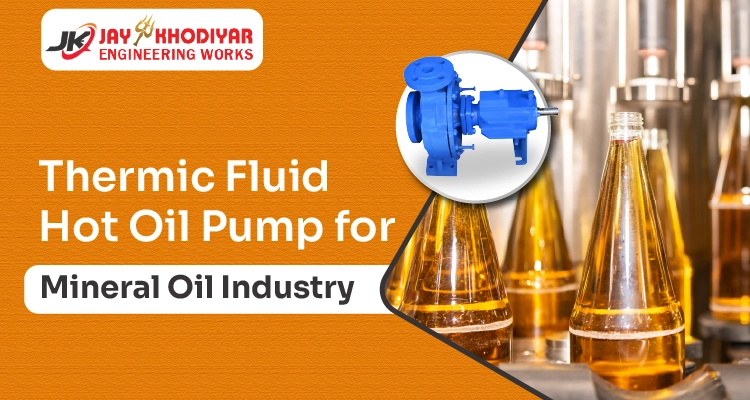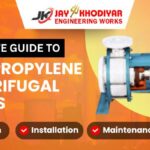
Complete Guide to Polypropylene Centrifugal Pumps: Selection, Installation & Maintenance
June 16, 2025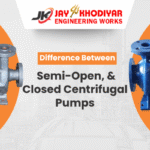
Difference Between Semi-Open and Closed Centrifugal Pumps
July 15, 2025Industrial heating systems lose up to 30% efficiency when using inadequate pumping solutions. Hot oil pumps are specialized equipment designed to circulate thermal fluids at temperatures ranging from 150°C to 400°C, ensuring optimal heat transfer in critical industrial processes.
Jay Khodiyar Pumps have been engineering high-performance hot oil pumps for industrial applications, helping manufacturers achieve precise temperature control while reducing energy costs. This comprehensive guide covers everything you need to know about selecting, installing, and maintaining hot oil pumps for your thermal fluid heating system.
What Are Hot Oil Pumps and Why Do You Need Them?
Hot oil pumps are specialized centrifugal or positive displacement pumps engineered to handle high-temperature thermal fluids safely and efficiently. Unlike standard pumps, they feature heat-resistant materials, advanced sealing technology, and cooling systems to withstand extreme operating conditions.
The primary function is circulating thermal fluids through closed-loop heating systems. These pumps maintain consistent temperature throughout industrial processes, from chemical reactions to food processing operations.
Standard pumps fail at temperatures above 80°C due to seal degradation, bearing failure, and material expansion. Hot oil pumps operate reliably at temperatures up to 400°C using specialized metallurgy and engineering design.
Key applications include chemical processing, food manufacturing, textile production, pharmaceutical operations, and solar thermal systems.
How Do Thermal Fluid Heating Systems Work?
Thermal fluid heating systems use hot oil pumps to circulate heated fluids through a closed-loop network. The system heats thermal fluid in a heater or boiler, then pumps distribute this heated fluid to process equipment requiring temperature control.
The heated fluid transfers thermal energy to industrial processes, then returns to the heater for reheating. This continuous circulation maintains precise temperature control across multiple process points.
Advantages over steam systems include:
- Low pressure operation (reducing safety risks)
- Temperature range flexibility (150°C to 400°C)
- Higher energy efficiency (up to 15% improvement)
- Better temperature uniformity
- Reduced maintenance requirements
The system operates at atmospheric pressure, eliminating high-pressure safety concerns associated with steam systems. This makes thermal fluid systems ideal for applications requiring temperatures above 100°C without pressure vessel complications.
What Are the Types of Hot Oil Pumps?
1. Centrifugal Hot Oil Pumps
Centrifugal pumps are the most common choice for thermal fluid circulation. They provide high flow rates with continuous operation capabilities, making them ideal for large-scale industrial heating systems.
Jay Khodiyar's centrifugal pump and side suction centrifugal pump models feature custom impeller designs optimized for thermal fluid properties. The closed impeller centrifugal pump offers higher efficiency, while semi-open centrifugal pump designs handle fluids with suspended particles.
Best applications: General thermal fluid circulation, chemical processing, and food manufacturing operations requiring consistent flow rates.
2. Magnetic Drive (Sealless) Pumps
Magnetic drive pumps eliminate shaft seals entirely, preventing leakage of expensive or hazardous thermal fluids. The magnetic coupling transfers power without physical contact, ensuring zero-emission operation.
These pumps cost 20-40% more than sealed alternatives but eliminate seal replacement and fluid loss. They're essential for handling toxic or environmentally sensitive thermal fluids.
Ideal for: Pharmaceutical manufacturing, specialty chemical processing, and applications with strict environmental regulations.
3. Positive Displacement Gear Pumps
Rotary gear pump and SS rotary pump models provide precise flow control regardless of system pressure variations. They excel in high-pressure applications and when handling viscous thermal fluids.
Positive displacement pumps maintain constant flow rates even with changing system conditions. This makes them perfect for applications requiring exact thermal fluid delivery rates.
Best applications: High-pressure systems, precise temperature control, and viscous fluid handling in specialty manufacturing.
4. API-Standard Heavy-Duty Pumps
API (American Petroleum Institute) standard pumps meet rigorous specifications for oil and gas applications. These pumps feature robust construction for continuous operation in demanding industrial environments.
Applications include: Petrochemical processing, large-scale manufacturing, and any application requiring proven reliability standards.
Which Industries Benefit Most from Hot Oil Pumps?
1. Chemical and Petrochemical Processing
Chemical reactions often require precise temperature control between 200°C and 350°C. Hot oil pumps maintain consistent temperatures during distillation, polymerization, and chemical synthesis processes.
Jay Khodiyar's chemical process pump models feature corrosion-resistant materials and specialized sealing for handling aggressive thermal fluids in chemical environments.
Safety considerations include leak-proof operation and emergency shutdown capabilities when handling hazardous materials.
2. Food and Beverage Manufacturing
Food processing requires temperatures between 150°C and 250°C for cooking, baking, and sterilization. Hot oil pumps provide uniform heating without hot spots that could affect product quality.
FDA-compliant materials and sanitary design features ensure food safety and compliance. Easy cleaning and inspection capabilities support Good Manufacturing Practices (GMP).
Applications: Commercial baking ovens, frying operations, sterilization systems, and pasteurization equipment.
3. Textile Industry
Textile dyeing and finishing processes require precise temperature control for colour consistency and fabric quality. Hot oil pumps maintain stable temperatures during heat setting and drying operations.
Temperature variations of just 5°C can cause color inconsistencies, making reliable thermal fluid circulation critical for quality control.
4. Pharmaceutical Manufacturing
Pharmaceutical production demands exact temperature control and contamination prevention. Hot oil pumps provide consistent heating for tablet coating, granulation, and API synthesis processes.
cGMP (current Good Manufacturing Practice) compliance requires validated systems with documented temperature control capabilities.
5. Solar Thermal Power Systems
Concentrated solar power (CSP) systems use hot oil pumps to circulate heat transfer fluids through solar collectors. These pumps operate at temperatures up to 400°C in renewable energy applications.
The growing solar thermal market represents significant opportunities for specialized pump applications in clean energy systems.
How to Choose the Right Hot Oil Pump for Your Application?
1. Critical Technical Parameters
- Flow rate calculation: Determine required fluid volume based on heat transfer requirements. Typical industrial systems require 50-500 GPM flow rates.
- Head pressure requirements: Calculate total system head including pipe friction, elevation changes, and equipment pressure drops. Most systems operate between 50-200 feet of head.
- Temperature specifications: Select pumps rated 50°C above operating temperature for safety margins. Consider start-up viscosity changes when fluids are cold.
- Viscosity considerations: Thermal fluids become less viscous when heated. Design for start-up conditions when fluids are thickest.
2. Material Selection Criteria
- Pump casing materials: Carbon steel for temperatures below 300°C, stainless steel for higher temperatures or corrosive fluids.
- Impeller materials: Cast iron, stainless steel, or specialized alloys depending on temperature and fluid compatibility.
- Sealing technology: Mechanical seals for standard applications, magnetic coupling for zero-leak requirements.
- Bearing considerations: High-temperature greases and cooling systems for extended bearing life.
3. Efficiency and Performance Factors
- NPSH requirements: Net Positive Suction Head analysis prevents cavitation. Hot fluids have lower NPSH available due to the vapor pressure effects.
- Energy efficiency: Variable speed drives can reduce energy consumption by 20-40% in systems with varying heat demands.
- Future expansion: Size systems for 20% capacity growth to accommodate production increases.
Need help selecting the right pump? Get expert consultation →
Best Installation Practices for Hot Oil Pumps in Thermal Fluid Systems
1. Foundation and Alignment
Proper foundation design prevents vibration and maintains pump alignment under thermal expansion. Use flexible pipe connections to accommodate thermal growth.
Vibration isolation pads reduce structure-borne noise and extend bearing life. Align pumps when the system is at operating temperature for optimal performance.
2. Piping Design Considerations
Install expansion joints to accommodate thermal growth. Support piping independently from pumps to prevent stress transfer.
Design piping slopes for complete drainage during maintenance. Install isolation valves for safe pump removal without system shutdown.
3. Cooling System Integration
Air-cooled pump designs use ambient air circulation for temperature control. Water cooling systems provide more effective temperature management in high-temperature applications.
Cooling extends seal and bearing life significantly. Most hot oil pumps require some form of cooling for reliable operation above 200°C.
4. Start-up Procedures
Gradual temperature increase prevents thermal shock. Heat systems slowly over 2-4 hours to reach operating temperature.
Check alignment and vibration at operating temperature. Initial start-up monitoring prevents early failures and ensures optimal performance.
How to Maintain Hot Oil Pumps for Long-Term Performance?
1. Preventive Maintenance Schedule
- Daily monitoring: Check bearing temperature, vibration levels, and seal leakage. Record operating parameters for trend analysis.
- Weekly tasks: Lubricate bearings, verify coupling alignment, inspect for unusual noise or vibration.
- Monthly inspections: Check seal condition, bearing temperature trends, and cooling system operation.
- Annual overhauls: Complete pump inspection, seal replacement, and bearing assessment.
2. Thermal Fluid Management
- Monitor fluid quality monthly for oxidation and contamination. Replace thermal fluids every 2-5 years depending on operating conditions.
- Install side-stream filtration to remove contamination and extend fluid life. Proper fluid management reduces pump wear and extends service intervals.
3. Troubleshooting Common Issues
- Cavitation problems: Check NPSH available, verify suction line design, and monitor fluid temperature effects.
- Seal failure patterns: High temperatures, poor cooling, or contaminated fluids cause premature seal failure.
- Temperature-related issues: Thermal expansion, inadequate cooling, or improper material selection create operating problems.
Why Jay Khodiyar Pumps Is the Best Choice for Your Thermal Fluid System?
1. Manufacturing Excellence
Jay Khodiyar Pumps maintains strict quality standards with comprehensive testing of every pump. Rigorous quality standards ensure consistent manufacturing processes and superior quality control.
Advanced metallurgy and precision machining create pumps that exceed industry performance standards. Custom engineering capabilities address unique application requirements.
2. Engineering Expertise
Experienced engineers provide application analysis and pump selection guidance. Custom solutions address specific process requirements and operating conditions.
Thermal analysis and fluid dynamics modeling optimize pump performance for each application. Design validation through testing ensures reliable operation.
3. Comprehensive Service Support
From initial system design through ongoing maintenance, Jay Khodiyar provides complete support. Local service centers ensure rapid response for maintenance and repairs.
Training programs help operators maximize pump performance and reliability. Spare parts inventory reduces downtime for critical applications.
4. Competitive Advantages
Proven track record: Over 30 years serving industrial markets with reliable pump solutions.
Custom engineering: Application-specific designs optimize performance and efficiency.
Innovation focus: Continuous improvement in materials, design, and manufacturing processes.
Conclusion
Hot oil pumps are critical components in industrial thermal systems, requiring careful selection and proper maintenance for optimal performance. The right pump choice depends on application requirements, operating conditions, and long-term reliability needs.
Key selection factors include: flow rate requirements, temperature specifications, material compatibility, and maintenance considerations. Proper installation and preventive maintenance extend pump life and ensure reliable operation.
Ready to optimize your thermal fluid system? Jay Khodiyar Pumps offers free consultation to assess your requirements and recommend optimal solutions. Our engineering team provides application analysis, pump selection guidance, and complete system support.
Contact Jay Khodiyar Pumps today for a comprehensive evaluation of your thermal heating system requirements. Request a quote for custom-engineered solutions that deliver reliable performance and energy efficiency.







